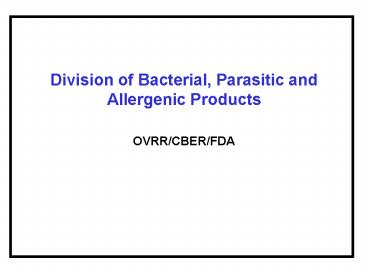Division of Bacterial, Parasitic and Allergenic Products OVRRCBERFDA - PowerPoint PPT Presentation
1 / 15
Title: Division of Bacterial, Parasitic and Allergenic Products OVRRCBERFDA
1
Division of Bacterial, Parasitic and Allergenic
ProductsOVRR/CBER/FDA
2
Division Mission and Functions
Assure safe and effective products for
immunological control of bacterial, parasitic,
and allergenic agents affecting human health
3
Examples of Possible New or Improved Products
Scope of DBPAP Product Responsibilities
- Respiratory Pathogens
- Streptococcus pneumoniae
- Mycobacterium tuberculosis
- Pseudomonas aeruginosa
- Neisseria meningitidis A,B,C,Y,W125
- Group B Streptococci
- Bordetella pertussis
- Chlamydia pneumoniae
- Corynbacterium diphtheriae
- Non-typeable H. influenzae
- Moraxella catarrhalis
- Sexually Transmitted Pathogens
- Neisseria gonorrheae
- Chlamydia trachomatis
- Pathogens Encountered by Penetrating Inoculation
- Borrelia burgdorfi
- Plasmodium species
- Leishmania species
- Clostridium tetani
- Staphylococcus aureus
- Schistosoma species
- Trypanosoma cruzi
- Special Pathogens (BT)
- Bacillus anthracis
- Clostridium botulinum
- Franciscella tularensis
- Yersinia pestis
4
Examples of Possible New or Improved Products
Scope of DBPAP Product Responsibilities
- Diarrhea-Causing Pathogens
- Enterotoxigenic E. coli
- Shigella species
- Vibrio cholerae
- Campylobacter jejuni
- Other Mucosally-Trafficking Pathogens
- Clostridium difficile
- Salmonella typhi
- Mycobacterium leprae
- Helicobacter pylori
- STEC and EPEC
- Allergenic Antigens
- Latex
- Cockroach
- Short ragweed
- Skin Test Antigens
- PPD
- Coccidioidin
- Leishmania
- Live Biotherapeutic Products
- Lactobacillus
- E. coli
- Clostridia
5
Division of Bacterial, Parasitic and Allergenic
Products (DBPAP)
Laboratory of Mycobacterial Diseases and
Cellular Immunology Sheldon Morris, Ph.D.-Chief
6
Division of Bacterial, Parasitic and Allergenic
Products (DBPAP)
- 6 Laboratories (82 people)
- 13 Tenured Principal Investigators
- 7 Tenure-track investigators
- 43 Full-time equivalent staff
- 19 Contract staff (e.g., post-doctoral fellows)
7
Laboratory Mission and Functions Dependent on
Researcher/Reviewers
Responsibilities of Researcher/Reviewers
- Conduct regulatory review
- Conduct critical research programmatic and
special task - Serve outside organizations as recognized subject
matter experts - Find outside resources to support research
8
Regulatory Review and Laboratory Work A
Synergistic Combination
- Provide reagents/standards
- Assay development
- Improved technology
- Trouble-shooting
- Gain expertise to
- Better anticipate issues/identify and fill
knowledge gaps - Provide expert input to vaccine community
- Provide guidance advice to industry
9
DBPAP Research Priorities
- Develop methods and models to assess and predict
vaccine and biologics safety and efficacy - Development and evaluation of novel vaccination
strategies and technologies - Development of animal models to predict vaccine
efficacy - Development of in vitro assays to predict vaccine
safety - Facilitate the development and evaluation of
vaccines for high priority diseases including
agents of bioterrorism - Development of improved conjugation technologies
- Development of genetic tools for allelic exchange
in B. anthracis - Evaluate novel approaches to improve vaccine
quality - Apply new NMR methods to analysis of carbohydrate
conformation - Development and evaluation of new methods and
assays for product characterization
10
Laboratory of Respiratory and Special Pathogens
- Areas of Research
- Studies of Bordetella pertussis, Bacillus
anthracis, C. diptheriae and C. botulinum and
Yersinia spp. - Characterization of Virulence Factors and Studies
on Mechanism of Action - Studies on Regulation of Gene Expression
- Animal Models of Infection
- Identification and characterization of
iron-regulated virulence factors - Mechanism of toxin entry into nerve cells, toxin
interaction with cellular components, and toxin
persistence
11
Laboratory of Methods Development and Quality
Control
- Research and Regulatory Activities
- Develop and evaluate
- Quality control methods for bacterial vaccines
- Assay methods for immune response measurement
- Animal models
- Bioassays for potency and toxicity
- Members are testing specialists
- Activities not restricted to single product area
12
LABORATORY OF BACTERIAL POLYSACCHARIDES
- Areas of Research
- Characterization of polysaccharide conjugate
vaccines - Conformation of polysaccharide antigens
- Biosynthesis of capsular polysaccharides
- Role of Neisseria outer membrane proteins in
disease - Interaction of polysaccharides with the immune
system
Neisseria
Oligosaccharide antigen
13
The Laboratory of Mycobacterial Diseases and
Cellular Immunology
- Areas of Research
- Evaluation of protective innate and adaptive
immune responses to intracellular bacteria - Assessment of live attenuated TB vaccine strains
and DNA vaccination strategies against
tuberculosis - Characterization of a unique family of
tuberculosis proteins
14
Laboratory of Immunobiochemistry
Allergen structure and function
Cockroach allergen standardization Microarray
method for potency determinations Determination
of optimal surrogate test Depletion analysis of
CR extracts
MDR proteins in T cell activation
Regulation of T cell responses by RSV
Extract potency determinations
Modifying allergic responses
Endotoxins and b-glucans in allergen extracts
15
Laboratory of Enteric and Sexually Transmitted
Diseases
- Areas of Research
- Invasion mechanisms of enteric pathogens
- Genetic regulation of bacterial virulence genes
- Mucosal immunity, dosing and adjuvants
- Anthrax and Shigella - Genetic analysis and
development of live attenuated Salmonella-vectored
vaccines































